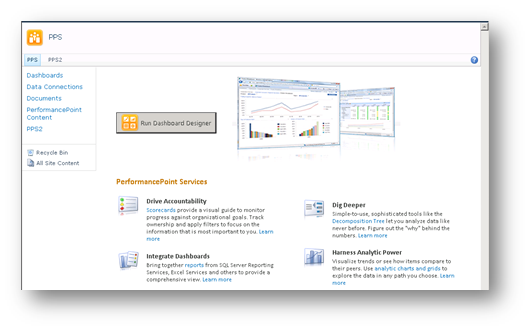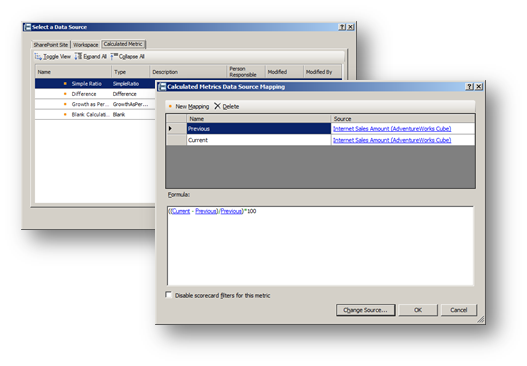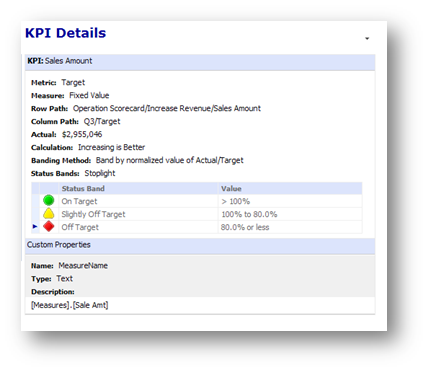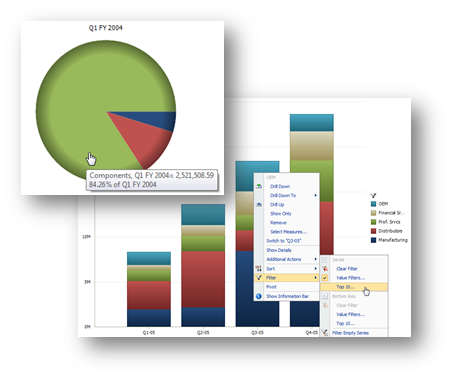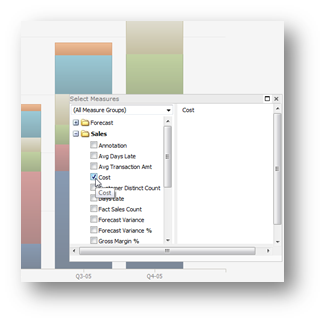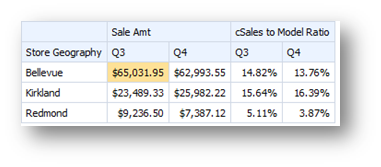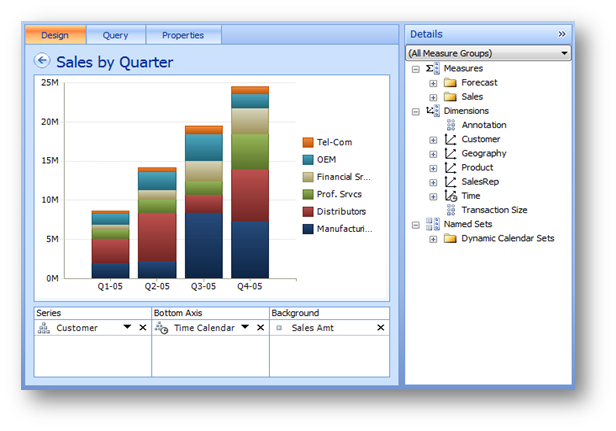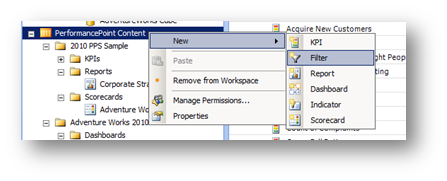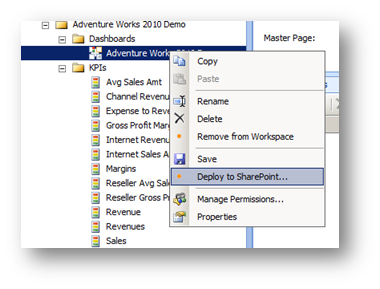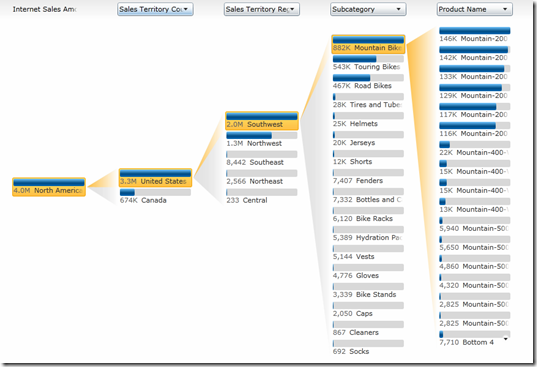New Features in PerformancePoint Services 2010
Now that SharePoint 2010 is on the horizon, there have been a lot of questions about what the differences are between PerformancePoint Server 2007 and PerformancePoint Services 2010. While most of the feature upgrades surround architectural changes, several changes have been made to enhance the user experience. Below are some of the upgrades that you will see in 2010.
Enterprise Deployment Scenarios
The following list highlights the greater attention to enterprise scalability of PerformancePoint Services 2010 over PerformancePoint Server 2007.
- Scale Up
- Scale Out
- Common Dashboard Framework and Infrastructure
- MOSS Installer Framework
- Enterprise Management Scenarios
- Familiar Administration Environment
- Fail Over
- Logging
- Ease of Deployment
- PowerShell Management Scripting
SharePoint Repository
Objects created in PerformancePoint 2010 are now stored in SharePoint lists and libraries, not in a separate database. Because of this new location, these other features come along too.
- Single Security Model
- Single Security Administration Environment
- Enterprise Management Scenarios
- Backup and Restore
- Disaster Recovery
- The PPS administrator’s user experience is the SharePoint user experience
- PerformancePoint is a SharePoint site
Filters compatible with SharePoint filters (WSS Connection Framework)
You can now use SharePoint’s standard connection framework to hook up PerformancePoint filters to standard SharePoint web parts.
Foundation for more seamless integration
The SharePoint architecture provides the foundation to make these things possible.
- Search, Indexing, Workflows
- Excel Services, Visio Server, Project Server
- Custom security implementations
Supported environments
New supported environments make it possible for PerformancePoint to run on the latest hardware, making the most out of the latest and greatest in speed and reliability.
- PerformancePoint Services for SharePoint
- Windows Server 2008 64-bit
- SharePoint Server O14 Enterprise CAL
PerformancePoint 2010 Clients
These are the client browsers and operating systems that are now supported.
- Windows XP or greater
- Internet Explorer 7.0 or greater
- FireFox 3.5
- Safari 3.5 (Mac only)
Scorecards
Scorecards have undergone significant changes. The following list should contribute to some fantastic performance indications.
- Dynamic hierarchies with navigation
- Drill Down and Drill Up
- Dynamic Selections, such as Children and Descendants
- KPIs on Columns
- Multiple Actual Values
- New Time Intelligence Formula Support
- Variance
- Calculated Metrics
- Scorecard hierarchies available for filters
- Cube formatting applied to KPIs
- Time intelligence formula editing
- Improved filtering
- Sort and filter on non-numeric values
- Improved value filtering
- Improved status filters
- Filter empty rows or columns
New report (KPI details)
Find out the fine details for each KPI.
- Displays information about KPIs
- Applied filters
- KPI name, description, properties
- Metrics with trend
- Actual and target values
- Created and modified date
- Indicator and thresholds
- Calculation
- Variance
- Scoring method and distribution graph
- Comments
- Person Responsible
Pie charts
A pie chart, a highly-requested chart type, has been added for PerformancePoint 2010.
Analytic reports
- Value filtering in grids and charts
- Change measure on published reports
- Navigation on bottom axis
- Improved numeric formatting
- Per-measure or per-column
- Analysis Services conditional formatting
Analytic view designer
Notice the UDM organized cube layout inside the Details pane.
Filters
Filters have come a long way in this version. Here are some of the enhancements
- Reusable between dashboards
- Compatible with SharePoint filters (WSS Connection Framework)
- Time Intelligence filters for multiple data sources
Dashboard deploy
PerformancePoint now has on-click deployment to SharePoint
Accessibility and Globalization
- Accessibility meets SharePoint standard
- Scorecard Analysis Services KPIs honor client locale
- Dashboard accessibility now meets SharePoint's standard (WCAG 2.0 AA)
New Visualization
Much like the decomposition tree from ProClarity, the one in PerformancePoint 2010 also helps customers follow a line of data to its logical conclusion.
And that about wraps up most of the new features in PerformancePoint Services 2010. If others come to mind, I’ll be sure to add them!
Kevin Donovan, Program Manager
PerformancePoint Services
Comments
Anonymous
November 05, 2009
Hi Kevin, I love the new Performance Point. Especially the time functions and calculated Metrics. Great work! Kasper de JongeAnonymous
November 06, 2009
I am looking forward to testing this new version of PerformancePoint. There is a real need for dynamic scorecards, so great it's available in this version. Aurélien KoppelAnonymous
November 25, 2009
The comment has been removedAnonymous
August 09, 2010
Hi, How to Deploy KPI to project server 2010 which is created using dashboard designer iqbalkmkAnonymous
October 28, 2010
Hi, nice article, how i can get % Pie chart ? i know it shows on mouseover , but is it possible to show it without mouse over as display alwaysAnonymous
December 09, 2010
The comment has been removedAnonymous
May 29, 2013
Hi, When you filter Empty Rows/Cols, "NON EMPTY" function gets attached to the MDX query in PPS. For reports having large datasets NonEmpty is preferred over NON EMPTY.Can you please explain how to implement NonEmpty function in PPS 2010.Anonymous
December 20, 2014
Do you have a similar article for PerformancePoint 2013?Anonymous
November 04, 2015
Hi, Can PPS cache or remember the last decomposed tree or can it be like a sticky session so user can use it for next time?

